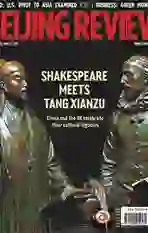A Meaningful Wartime Friendship
2016-06-08ByBaoShixiu
By+Bao+Shixiu
This year marks the China-U.S. Year of Tourism, a program designed to promote mutual understanding between the two nations. The year of tourism comes after a worldwide celebration last year of the 70th anniversary of the end of World War II (WWII), during which China and the United States fought side by side. These historical moments from the 1940s showcase a time of deep friendship between the two countries when they were united against a common opponent.
On July 22, 1944, then U.S. President Franklin Roosevelt sent the U.S. Army Observation Group, also known as the Dixie Mission, to Yanan in west China, where the Communist Party of China (CPC) was headquartered. The groups mission was to gather information on Japans battle placements in north and northeast China. At the same time, they also collected meteorological data for the U.S. Navy.
But the Dixie Mission had another separate goal of establishing relations with the CPC. The group arrived in two batches with a total of 18 members, who stayed in Yanan for more than two years. The final member left on March 11, 1947. During their stay, Chinese forces claimed victory over Japanese invaders with the support of other Allied countries including the United States in 1945. The groups interaction with senior CPC leaders, as well as military personnel in CPC-led armed forces and locals in Yanan increased friendship between the two countries and their militaries.
WWII and the Dixie Missions involvement helped cement the China-U.S. relationship based on common experiences. A member of the Dixie Mission even lost his life in the line of duty. On April 21, 1945, First Lieutenant Henry S. Whittlesey was killed by Japanese forces in Yushe County, located in the Taihang Mountains. The ties and memories created during that time have helped forge a bond between the two nations.
Captain John G. Colling, a member of the Dixie Mission, spent time in China as a young man and became familiar with Chinese culture and language, which he was able to speak. He detailed his experiences working with the CPC and shared some of what he saw during his time in Yanan, then spelt as Yenan, in his memoir The Spirit of Yenan—A Wartime Chapter of Sino-American Friendship. This included accounts of locals rebuilding homes and towns destroyed in the war. His book highlighted the determination that the Chinese demonstrated to win the war.
John Service, another member of the mission, predicted correctly that the CPC-led revolution would triumph in China. Though he fell victim to McCarthyism in the 1950s, his commitment to developing amicable ties with China never wavered. He visited China six times after relations between the two countries thawed in the 1970s.
Other members of the U.S. Army Observation Group also expressed sympathy for the plight of the Chinese during WWII. In addition, American friends outside the observation group offered their support to the Chinese people. One in particular was Evans Fordyce Carlson, who stayed with the CPC-commanded Eighth Route Army during the wartime period, despite facing shelling and bullets from enemy fighters.
Following President Roosevelts instructions after the United States declared war against Japan, Carlson created the famous Marine force, “Carlsons Raiders.”By drawing on the experiences of the Eighth Route Army, the raiders defeated Japanese forces in attacks on a number of Japanese-occupied islands. This was a telling example of the fruitful military-to-military exchanges between China and the United States during WWII. Following Japans surrender and the end of the war, Carlson worked to persuade officials in the United States to adopt positive diplomatic policies with China.
The Chinese people will forever remember the sincere help and support provided by their American allies during WWII. Those years should be a force to push forward friendship between China and the United States.
By studying history, we mean to learn from it and remember it. And when one puts it into perspective, WWII was not that long ago. But China-U.S. relations have undergone various ups and downs since the U.S. Government sent the Dixie Mission to China in the 1940s. Today, a rising China is facing unprecedented tests at home and abroad. We need more people with insight like Colling, Service and Carlson to remove misunderstandings and forge consensus. The three worked to boost mutual confidence between the two nations. The peace created after WWII can only continue if the two countries strengthen their partnership.
